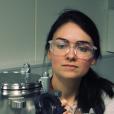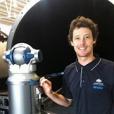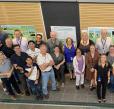
Science Operations Manager
Danielle is currently the Acting Senior Principal Scientist, who oversees strategic developments, managing, prioritising and facilitating team interactions, capital and asset management programs and leading improvement initiatives across the ANSTO Melbo

Director of the new Environment Research and Technology Group
Role at ANSTO
Dr Karina Meredith was appointed Director of the new Research and Technology Group for Environment effective 15 January 2024.

Scientist - MEX
Role at ANSTO

Synthetic Biologist and Biochemist
Role at ANSTO
A study has provided insight into copper sulfate pentahydrate and could give clues to how other hydrated minerals change under the pressures within planetary environments
Recent news, highlights, and impact case studies from CAS’ research and industry user communities and collaborations/partners
Elastic Recoil Detection Analysis (ERDA) is used principally as a method for measuring hydrogen in thin layers, and in the near-surface region of materials.
Participants undertook IAEA training hosted by Macquarie University and ANSTO on use of radionuclides for soil and water investigations.
A major study has identified urbanisation and climate change as future threats to drinking water quality.
ANSTO is celebrating the official opening of HIFAR, Australia’s first nuclear reactor, sixty-five years ago.
An Australian-led international research team, including a core group of ANSTO scientists, has found that doping a promising material provides a simple, effective method capable of extracting uranium from seawater.
Collaboration across the Tasman has enabled Australian and New Zealand researchers and scientists to shed light on a protein involved in diseases such as Parkinson’s disease, gastric cancer and melanoma.
The mining industry is set to benefit from a new Australian capability that uses a nuclear scanning technique to detect the presence of precious metals and strategic minerals in a core sample.
Structure of protein involved in immune response pair revealed.
The protein mapping workhorses of the Australian Synchrotron, Macromolecular and Microfocus crystallography beamlines, MX1 and 2, continue to support important biomedical research in the development of vaccines and new therapeutics.
A pioneering study led by Professor Junpei Yamanaka of Nagoya City University and an international team that included ANSTO has delivered transformative insights into the behaviour of colloidal particles under microgravity.

Technical Officer
Matt Bell is a technical officer with a background in mechanical engineering. Matt started at ANSTO in 1993 as a Fitter & Machinist apprentice in the Engineering Workshop.
Our Year 12 Physics tour and depth study guide can be used as the starting point for a depth study about nuclear science, covering nuclear-related components of Module 8: From the Universe to the Atom.
All tours are available Monday to Friday for Years 7 to 12 classes. The cost per student is $12.50 and teachers are free.
Please print enough copies of the relevant workbook for your class before your visit to ANSTO.
Our Year 11 Chemistry tour and depth study guide can be used as the starting point for a depth study about nuclear science, covering nuclear-related components of Module 1: Properties of Structure and Matter.
All tours are available Monday to Friday for Years 7 to 12 classes. The cost per student is $12.50 and teachers are free.
Please print enough copies of the relevant workbook for your class before your visit to ANSTO.
Pagination









